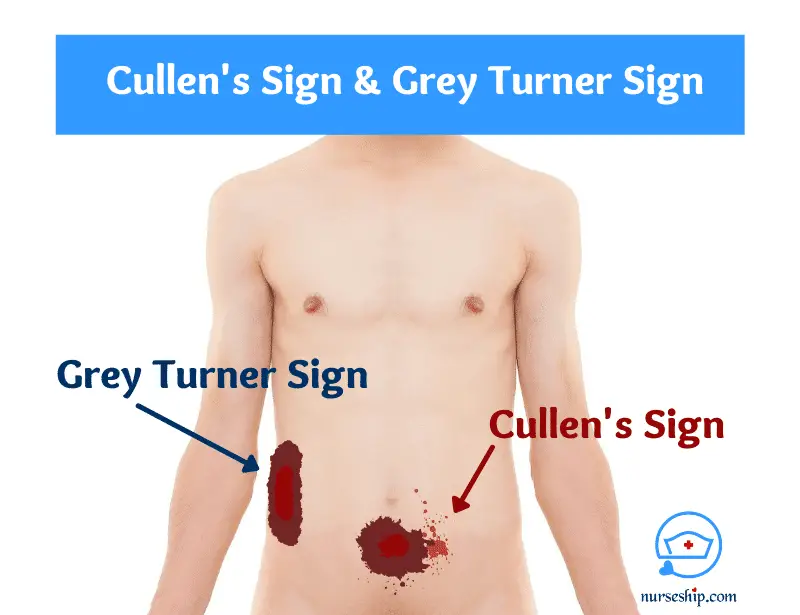Last updated on December 28th, 2023
Cullen’s Sign
Cullen’s sign refers to the appearance of skin discoloration around the periumbilical region due to edema and bruising of subcutaneous fatty tissue underneath. Initially, the sign was described in a case of ruptured ectopic pregnancy. Later it was also commonly attributed as a sign of acute pancreatitis.
Cullen’s sign is defined as an ecchymosis at the periumbilical area due to retroperitoneal bleeding.
Additionally, positive Cullen’s sign has been reported in various medical conditions such as perforated duodenal ulcer, percutaneous liver biopsy, ruptured abdominal aortic aneurysm, metastatic thyroid cancer, post angiographic or radiological interventions, pancreatic or abdominal trauma, amoebic liver abscess, and many more. To all conditions, the common factor in the appearance of Cullen’s sign is retroperitoneal bleeding.
The presence of Cullen’s Sign and Grey Turner’s sign in acute pancreatitis has a very poor prognosis. A study reports a 37 percent mortality rate when both signs are present with acute pancreatitis.
History of Cullen’s Sign
Cullen’s sign is named after Canadian Gynecologist Dr. Thomas Stephen Cullen (1868–1953). He first described this sign in 1918 following a ruptured ectopic pregnancy.
Thomas Stephen Cullen was a professor at John Hopkins Hospital and he extensively studied gynecological diseases such as ectopic pregnancy and uterine cancer.
Mechanism of Cullen’s Sign
The retroperitoneum is linked to the gastro-hepatic ligament, followed by the falciform ligament, and lastly to the round ligament. Which is the pathway of the abdominal wall around the umbilicus.
Therefore, when a hemorrhage (bleeding) occurs from any causes, the blood can travel via these ligaments to the abdominal wall to form ecchymoses [Cullen’s sign] at the periumbilical area.
Causes for positive Cullen’s sign
There are multiple medical conditions associated with positive Cullen’s sign.
A positive Cullen’s sign is more commonly seen in the following conditions.
- Retroperitoneal bleeding
- Post-surgery
- Iatrogenic – anticoagulation complication, postoperative
- Rectus sheath hematoma

Following are the conditions where a positive Cullen’s sign is rarely seen.
- Ectopic pregnancy
- Intrahepatic haemorrhage
- Ischaemic bowel
- Ruptured abdominal aortic aneurysm
- Amoebic liver cyst
- Perforated duodenal ulcer
- Ruptured spleen
- Hepatocellular carcinoma
Clinical significance of Cullen’s sign
In spite of the fact that Cullen’s sign is well-known as a sign of pancreatitis, evidence suggests only 1-3 percent of acute pancreatitis cases elicit Cullen’s sign. Similarly, for ruptured ectopic pregnancy, it is just 1 percent.
Hence, Cullen’s sign is an extremely non-specific sign of pancreatitis. Literally, a study reports only 9 showed positive Cullen’s sign of 770 cases of pancreatitis.
However, Cullen’s sign is a highly specific indicator of retroperitoneal hemorrhage. Hence, the presence of ecchymoses always required comprehensive history taking and additional investigations.
Nursing consideration in Cullen’s Sign
If you notice an ecchymosis (discoloration of the skin due to internal bleeding) around the umbilical region, ensure to take an in-depth patient history and immediately notify the findings to the clinician in charge.
Because it could be an indication of serious retroperitoneal bleeding which warrants urgent investigations and treatment.
Reference
Dennis, M., Bowen, W., & Cho, L. (2016). Mechanisms of Clinical Signs (2nd ed.). Elsevier Australia.White, F. (2009). Physical signs in medicine and surgery. Museum Press.



Comments are closed.